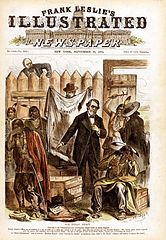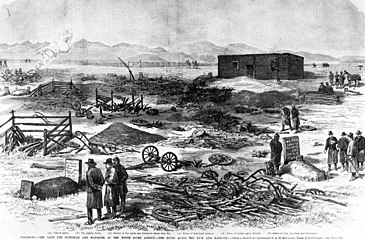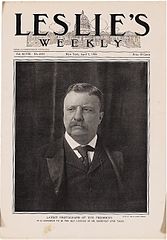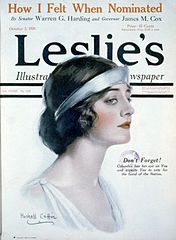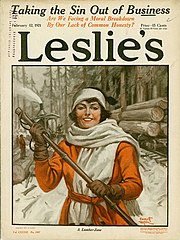Frank Leslie's Illustrated Newspaper
 USSGovernor MiltonbyFrank Leslie's Illustrated Newspaper | |
| Categories | Literary and news |
|---|---|
| Publisher | Frank Leslie |
| First issue | 1855 |
| Final issue | 1922 |
| Country | United States |
Frank Leslie's Illustrated Newspaper,later renamedLeslie's Weekly,was an American illustrated literary and news magazine founded in 1855 and published until 1922. It was one of several magazines started by publisher and illustratorFrank Leslie.
Throughout its existence, the weekly provided illustrations and reports—withwood engravings,lithographsandsteel engravingsbased on sketches and photography, beginning withdaguerreotypesand later with more advanced forms of photography—of wars fromJohn Brown's raid atHarpers Ferryand theCivil Warto theSpanish–American Warand theFirst World War- and numerous other articles of topical interest.
Surviving issues today are prized by collectors' for their vividly depicting American life during the seven decades of its existence. Many distinguished writers were featured in its pages.
History
[edit]Background
[edit]Frank Lesliewas thepen nameof Henry Carter (1821–1880), the son of a well-to-do English glovemaker.[1]Carter had taken up the art of wood engraving over his father's objection and emigrated toNew York Cityto make his own way in the world, arriving in 1848.[1]Carter—who adopted the Frank Leslie name immediately upon his arrival—was unable to find a position as an illustrator with an established newspaper in the city and was forced to open his own business, a small engraving shop on Broadway.[2]
One of Leslie's early clients was promoterP. T. Barnum,who commissioned Leslie to produce a posh illustrated concert program for singerJenny Lindin 1849.[3]Additional work was done for Barnum for another Lind tour in 1850 and 1851.[3]When Barnum decided to launch a publication calledThe Illustrated Newsin 1853, he turned to Leslie, hiring him as chief engraver for the short-lived publication, which failed within its first year of existence.[3]
Out of a job once more, Leslie decided to begin publishing on his own, launching two new periodicals in 1854—Frank Leslie's Ladies' Gazette of Fashion,a fashion-oriented newspaper, andFrank Leslie's Journal of Romance,an illustrated fiction magazine.[3]Both of these publications proved to be financially lucrative, and in 1855, Leslie added a third publication to his stable, an illustrated news weekly calledFrank Leslie's Illustrated Newspaper.[3]
Early years
[edit]
The first years ofFrank Leslie's Illustrated Newspaperwere difficult, with the nation undergoing a business crisis in 1857.[3]The drama of the massiveAmerican Civil Warin 1861, though, ensured the success ofLeslie's Newspaper,as tens of thousands of readers turned toLeslie'sand the upstartHarper's Weeklyfor their sometimes lurid illustrations of the bloody conflict.[3]ALeslie'sfreelancer,James R. O'Neill,is believed to have been the only Civil War correspondentkilled in actionin the Civil War.[4][5]
No daily newspaper in America consistently carried illustrations until the launch of theNew York Daily Graphicin 1873, by which timeLeslie's Newspaperwas a massive and prosperous concern, employing more than 300 people, including 70 illustrators, as part of a publishing empire which by now spanned seven publications.[3]
Production process
[edit]
Leslie's Newspaperaveraged 16 pages and was frequently accompanied by supplements or expanded into special thematic editions.[6]Content strove to be timely, focusing on the newsworthy events of the previous week, often within days of its occurrence, a novelty for the era.[6]Art was produced by teams, with initial sketches selected by an editor and turned over to an illustrator, who produced an outline drawing.[6]The outline was then applied to a block consisting of multiple layers of Turkishboxwoodand additional detail added by specialized artists.[6]
The large block of wood was then separated into its constituent pieces and turned over to the engraving department, which meticulously carved out the white sections, leaving the black illustration in relief.[6]The sections of the wood block were then rejoined and sent to the composing room, where the illustration was converted to part of an electrotyped copper plate for printing.[6]
Years after Frank Leslie's death
[edit]After Leslie's death in 1880, the magazine was continued by his widow,women's suffragecampaignerMiriam Florence Leslie.The name, by then a well-established trademark, remained also after 1902, when it no longer had a connection with the Leslie family. The magazine was merged intoJudge(which was under the same ownership) effective with the June 24, 1922 issue,[7]having switched to a monthly publication in February, 1921, shortly after its parent company was placed into receivership.[8]
It often took a stronglypatrioticstance and frequently featured cover pictures of soldiers and heroic battle stories. It also gave extensive coverage to less martial events such as theKlondike gold rushof 1897, covered bySan Franciscojournalist John Bonner.
Among the writers publishing their stories in the weekly wereLouisa May Alcott,H. Irving Hancock,Helen R. Martin,Eleanor Franklin Egan,andEllis Parker Butler.Several notable illustrators worked for the publication, includingAlbert BerghausandNorman Rockwell,who created covers for the magazine in its latter years,Emmett Watson,andFernando Miranda y Casellas.James Montgomery Flagg's iconic depiction ofUncle Samfirst appeared publicly on the cover of the July 6, 1916, issue, with the caption "What Are You Doing for Preparedness?", before becoming a famed recruiting poster on American entry into World War I.[9][10]Pioneering aviatorHarriet Quimbywas a frequent contributor for 10 year, serving as the magazine's aviation editor after she became the first American woman to become a licensed pilot in 1911, after several years of writing for the magazine on a number of different subjects (including serving as the magazine's drama critic). Some of her final writings for the magazine were on the topic of aviation and aviation safety, with her final article appearing in the issue published a week after her death in a flying accident on July 1, 1912.
By 1897, the publication's circulation had grown to an estimated 65,000 copies.[11]
See also
[edit]Gallery
[edit]-
Mary Todd Lincolnwith sons William and Tad; steel engraving from photograph (December 15, 1860)
-
An 1863 lithograph showing GeneralStephen G. Burbridgeplanting theUnionflag after thecaptureofArkansas Post
-
Joseph KepplerColored lithograph ridiculing U.S. Indian policy (September 18, 1875)
-
TheRepublican National ConventionatCincinnati;lithograph likely derived from a photograph (July 1, 1876)
-
An 1879 lithograph illustration depicting theMeeker Massacrein Colorado
-
Woodcut of a romanticPuritancouple (December 12, 1885)
-
Colored lithograph cover about theSpanish–American War(June 30, 1898)
-
PresidentTheodore Roosevelt;halftone photograph (April 7, 1904)
-
Fact and FictionbyNorman Rockwell(January 11, 1917)
-
Cover promoting participation in thefirst presidential electionsince ratification of theNineteenth Amendment(October 2, 1920)
-
A Lumber-JanebyEmmett Watson(February 12, 1921)
References
[edit]- ^abJoshua Brown, "The Great Uprising and Pictorial Order in Gilded Age America", in David O. Stowell (ed.),The Great Strikes of 1877.Urbana, IL: University of Illinois Press, 2008; p. 19.
- ^Brown,The Great Uprising and Pictorial Order in Gilded Age America,pp. 19-20.
- ^abcdefghJoshua Brown,The Great Uprising and Pictorial Order in Gilded Age America,p. 20.
- ^Steele, Phillip W.; Cottrell, Steve (1993).Civil War in the Ozarks.Gretna, Louisiana: Pelican Publishing Company. pp. 74–83.ISBN0-88289-988-0.
- ^"O'Neill and the Band: The Baxter Springs Massacre Part One".Civil War Wisconsin.Wisconsin Civil War Sesquicentennial Commission. March 30, 2011.RetrievedFebruary 26,2017.
- ^abcdefBrown,The Great Uprising and Pictorial Order in Gilded Age America,p. 21.
- ^Nelson, Randy F.The Almanac of American Letters.Los Altos, California: William Kaufmann, Inc., 1981: 66.ISBN0-86576-008-X
- ^"Leslie's To Be Monthly"(PDF).The New York Times.Vol. LXX, no. 23, 044. February 26, 1921. p. 6.RetrievedFebruary 27,2021.
- ^"The Great War: Part 1 - Transcript".American Experience.PBS. July 3, 2018.RetrievedMay 7,2019.
- ^"What are YOU doing for preparedness?".Library of Congress: Prints & Photographs Online Catalog.Library of Congress.RetrievedMay 7,2019.
- ^N. W. Ayer & Son,The American Newspaper Annual(New York, 1897)1896: Journals of the Campaign).
Further reading
[edit]- Joshua Brown, "The Great Uprising and Pictorial Order in Gilded Age America," in David O. Stowell (ed.),The Great Strikes of 1877.Urbana, IL: University of Illinois Press, 2008; pp. 15–54.
External links
[edit]- 1890 volume of paper,via Google books
- 1917-1918 issues covering the Great War,via Digital Library@Villanova University
- Coverage of the laying of the 1858 Atlantic Cable inFrank Leslie's Illustrated Newspaper
- "At the Gate of Klondike" by John Bonner inFrank Leslie's Illustrated Newspaper,1858Archived2019-05-05 at theWayback Machine
- Sketch depicting Oscar Wilde fromLeslie's Weekly
- The San Francisco Earthquake inLeslie's Weekly
- Leslie's Weekly,Volume 133, Issue 3451. From Google books.
- Accessible Archives has complete set (institutional subscription required)



